Comet 4c - Liveries - Misrair (United Arab Airlines)
20/04/12 18:00
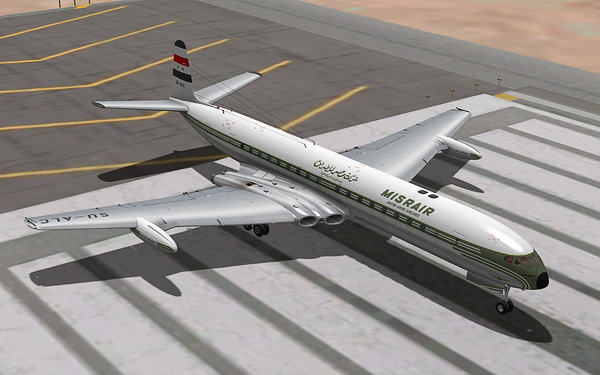
Fig. 1: Comet 4C SU-ALC in Misrair (United Arab Airlines) colours at HECA (Cairo International Airport, Egypt).
In 1932, Talaat Harb decided to start an airline. It was a joint venture, with Bank Misr (which Harb had founded in 1920) providing the capital and a British company, Airwork, providing the expertise. Airwork had considerable experience as a sub-contractor to the RAF, offering aircraft maintenance and elementary flight training from their headquarters at Heston Aerodrome, in Middlesex.
Misr Airwork offered Airwork’s usual services in Cairo, plus an airline. They developed a long association with de Havilland, becoming their representative in the Middle East, and operating a fleet of exclusively de Havilland aircraft, including the DH-82 Tiger Moth, DH-84 Dragon, DH-86 Express and DH-89 Rapide.
In a letter to the de Havilland Gazette in November 1937, the Managing Director of Misr Airwork, Kamal Eloui Bay, wrote:
“We fly over 1,000,000 miles per annum of regular air services with your machines. Moreover, D.H. aircraft have up to now been exclusively used in our flying schools, and for charter work. The fleet gives us every satisfaction at low cost”
In September 1939, the Egyptian government took over the business, and the name was changed to Misr Airways. After the War, they returned to civil aviation in partnership with BOAC, which allowed them access to modern procedures and training, and also to British Commonwealth routes, while BOAC gained access to Egypt. They abbreviated the name to Misrair in 1949, and bought a fleet of 10 Vickers Vikings from their old friends, Airwork.
After the military coup in 1952, Misrair languished under Naguib, but flourished again under Nasser, who wanted Egypt to have a proper national airline. In 1955, they bought a new fleet of Vickers Viscount turbo-props, which enabled them to open routes between Cairo and London, via Rome, and either Frankfurt, Geneva or Zurich. In 1958, they decided to buy jets.
In 1960, Flight Magazine wrote about Misrair’s decision to choose the Comet:
“Mr Gazarine spoke highly of the Rolls-Royce and Vickers support for the Viscounts that they have operated since 1955, and he said that Misrair felt the same degree of confidence in de Havilland. Despite the most attractive offers from American jet airliner manufacturers who had, he said, “almost offered to give their aeroplanes to us,” Misrair had always wanted the Comet.
“The deputy technical director, Hussain Tewfik, said: “We know British aircraft and we want to go on buying them.” The Russians had offered Tu-104s at “very extended hire purchase terms,” though with “unacceptable” condition that engine overhauls had to be carried out in Russia. Misrair was, he said, interested in the VC10 as a possible successor to the Comet 4C.”
Meanwhile, Nasser’s efforts to unite the whole of Arabia resulted in Egyptian and Syrian governments merging their national airlines to form United Arab Airlines in 1961. It was not a success. By October 1961, Syria pulled out. At the same time, Egypt’s move towards socialism raised heckles in the West; tourism collapsed, UAA struggled to maintain the Viscounts and Comets without enough cash for spares, and there were a number of serious accidents. After the Six-Day War in 1967, things improved, tourism returned and Western money became available again. United Arab Airlines became Egypt Air in 1971.
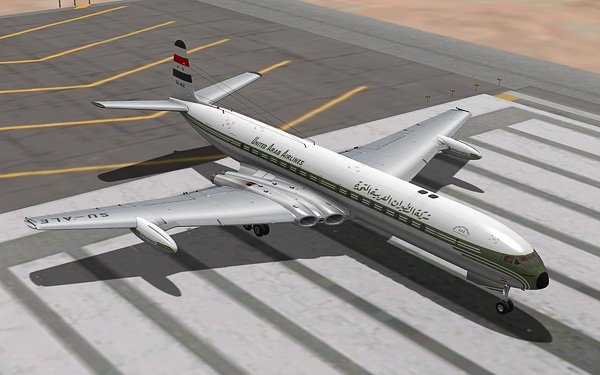
Fig. 2: Comet 4C SU-ALE in United Arab Airlines colours at HECA (Cairo International Airport, Egypt).
None of this was clear to me when I started. In books, it appeared that there were Comets with the same green stripes, variously painted Misrair, United Arab Airlines and Egypt Air. Since most of the photographs were in UAA colours, I arrived at the misconception that this was the most successful period. In fact “Misr” means “Egypt”, so UAA could be regarded as a brief and messy interlude in Egyptian operations.
My self-imposed rule has been to draw liveries as the aircraft looked when it was brand new, ex-works. The exception is Dan Air, simply because of the strength of association with the Comet. Wherever possible, the paintwork has been based on the first aircraft delivered to the airline. With Misrair, the name changed while the order with de Havilland was in progress, therefore I decided to make liveries for the first (Misrair/UAA, SU-ALE, c/n 6439) , and the third (UAA, SU-ALE, c/n 6444). The later Egypt Air schemes were repaints. Either I shall add repaints later, after release, or I’ll make a paint kit and someone else can have a go!
The differences between “Misrair” and “UAA” schemes are shown in Fig. 1 and Fig. 2. By 1960, UAA changes were definitely in the wind, and it’s written under the word “Misrair”. The airline logo on the nose is different as well, and UAA introduced new writing over the passenger and crew doors.
English language lettering changed twice, while the Arabic script changed four times. The script that went with “Misrair” is a stylised, simplified and extended version of the Arabic for “Egypt Air”, but I can not decipher what the various scripts say that go with UAA. I simply found a good photograph of SU-ALE, compared it with the UAA timetables for 1961, and re-drew it by hand. If you know the answer, or spot a howling mistake in my artwork, please let me know!
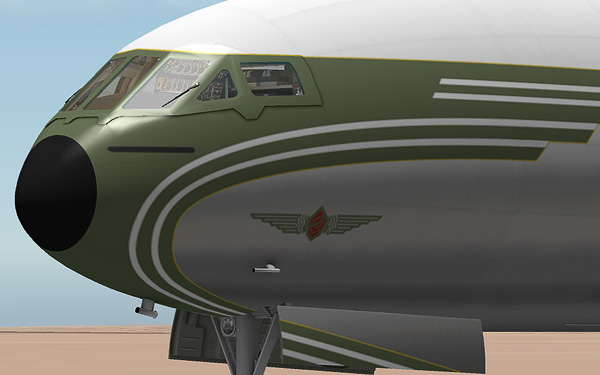
Fig. 3: Detail of Comet SU-ALC nose, Misrair/UAA stripes and logo common to Misr Airwork, Misr Airlines and Misrair.
Multiple stripes were challenging. There is a bit of variation in scale as the UV map bunches towards the nose, which is hidden by a single broad stripe, but there was nowhere to hide with these. As well as the green and white stripes, there is also a thin yellow stripe at the edge of the green, wrapping over the windscreen reinforcement.
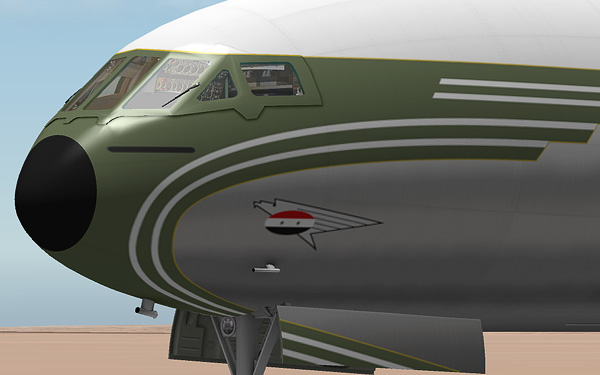
Fig. 4: Detail of Comet SU-ALE nose, Misrair/UAA stripes and United Arab Airlines logo. A falcon, representing Horus, the falcon-headed god of the sky, continued to be used, and still features on Egypt Air’s logo.
The black strip under the windscreen is a composite strip housing an ADF antenna. These were on all Comets up to the Comet 4, but not usually on the Comet 4B or 4C, even those operating between other Arabian countries.
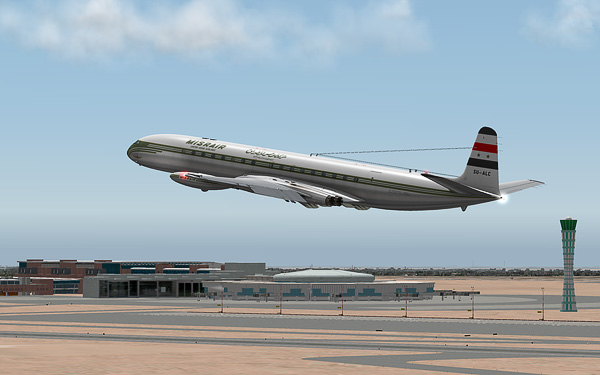
Fig. 5: SU-ALC climbing away from HECA, runway 23L. Imagine the noise ...

Fig. 6: SU-ALC Turning near Cairo.

Fig. 7: SU-ALC turning over Cairo.
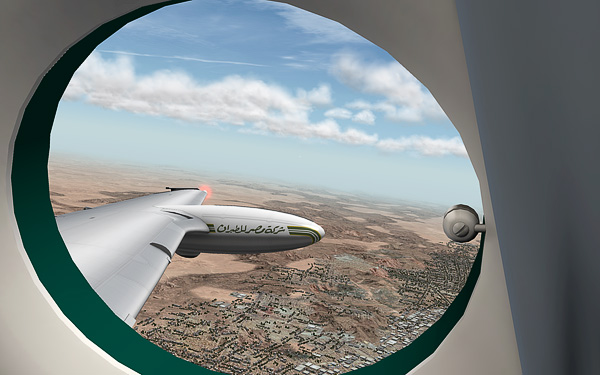
Fig. 8: SU-ALC over Cairo, a standard view from a first class seat, or [F7] when using Sandy Barbour’s Pilot View and the configuration file that will be included with the Comet. The fuel nacelle tanks have a similar stripe to the fuselage, with Arabic on the right and English on the left.
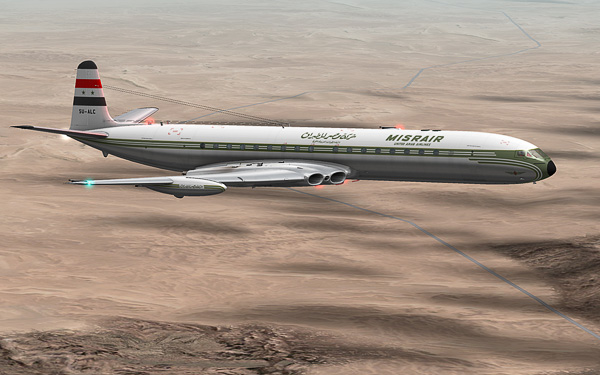
Fig. 9: SU-ALC near Cairo.
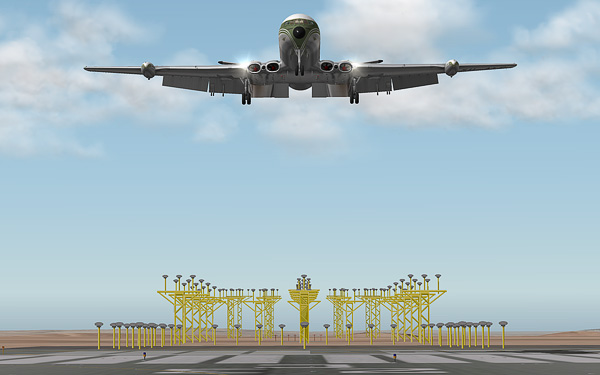
Fig. 10: SU-ALC over the threshold at HECA, with flaps fully deployed (set to 80º).
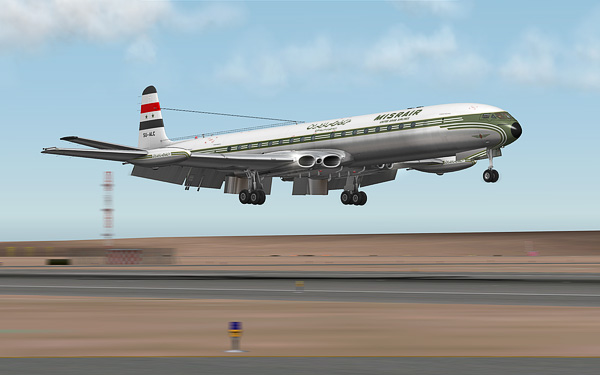
Fig. 11: SU-ALC landing at HECA. Note the dangle on the main gear wheels, which is the opposite of what one sees on modern Boeings and Airbuses. It is intentional, from angles given in the Comet 4C Maintenance Manual. A perfectly executed flare makes fore and aft main wheels touch together, or so it says. I can’t say I’ve achieved it yet, but that’s down to my own cack-handed flying skills.
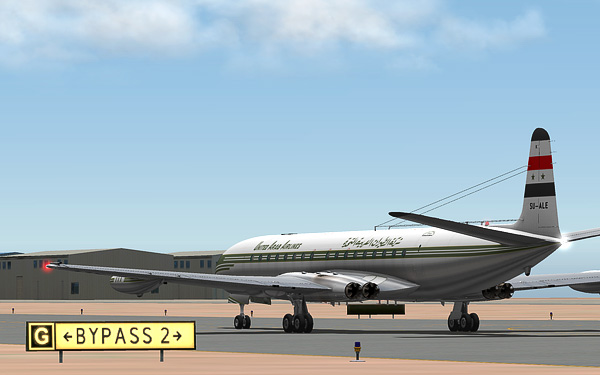
Fig. 12: SU-ALE taxying at HECA.
Next step:
I am going to make one more airline livery for the Comet 4C: Sudan Airways. Clavel 9 is making the A&AEE livery for XS-235 “Canopus” (c/n 6473), which also requires additional exterior modelling from me and a completely different interior. Similarly the VIP transport for King Saud of Saudi Arabia (SA-R-7, c/n 6461), which would look totally wrong with rows and rows of passenger seats. They can only be done when I have enough information, and will not spend time on this until after release.
History sources:
de Havilland Gazette
DH106 Comet, An Illustrated History, by Martin Painter
Flight Global Archive
Reference For Business
Wikipedia
Additional credits:
Add-on scenery of HECA (Cairo International Airport), shown in the screen shots, is originally by Ahmed Hussien (Vateg) for Microsoft Flight Simulator, converted by Ahmed Akram and distributed as freeware by X-Plane.Org.
--
GMM-P (20/04/2012)
blog comments powered by Disqus
